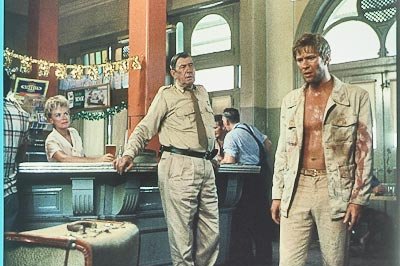Suntanned, shirtless and sweaty, the late out actor Gary Bond cuts a striking, sexy figure in “Wake in Fright. ” Directed by Ted Kotcheff, this “lost” film — it was made in Australia in 1971 but rarely screened — opens Nov. 16 at Ritz at the Bourse. It is an intriguing drama about masculinity and sexuality that provides viewers with an experience that is hard to shake.
Bond plays John Grant, a handsome, thin, blond schoolteacher in the Australian Outback town of Tiboonda. He exerts control over his classroom, but it seems to be the only control he has in his life. John is unhappy with his post, and needs to raise $1,000 to buy out his bonded contract. As the film opens — with a stunning 360-degree shot of the Outback that provides a fitting motif for the story — John is departing for Sydney and Christmas holidays with his girlfriend (seen only in flashback).
John’s travel plans require him to first spend the night in Bundanyabba, known locally as “The Yabba.” The locals here are friendly — perhaps too friendly — and John, who is effete and therefore an outsider looks warily at what appears to be a hyper-masculine culture. (The idea of outsiders in the Outback is also expressed silently as John shares his train ride to The Yabba with an Aboriginal passenger.)
In town, John is soon befriended by Jock (Chips Rafferty), a local cop who buys him several drinks and informs him that the town is a place where most of the folks who leave it do so via suicide. John also shares a meal with “Doc” Tydon (Donald Pleasence), the local medic, who is short and often shirtless, but perhaps the most imposing figure in town.
Introduced to a coin-tossing game in the bar, John earns almost enough money to buy out his teaching contract. But when he gets greedy and loses all his cash, John ends up stuck in The Yabba.
“Wake in Fright” is highly engrossing up to this pivotal moment, when the film takes an unusual turn, going off in some fascinating and unexpected directions that make it utterly compelling.
The morning after John loses his money, he wakes up naked, alone and face-down in his hotel room. (His exposed bare buttocks symbolically stand out as unmarked territory against the rest of his beautiful bronzed body. Ideas of John being reborn and/or ripe for corruption also abound.) John’s financial situation forces him to leave his hotel and rely on the kindness of strangers as he remains in town.
However, things quickly get stranger and stranger. John is taken in by Tim Hynes (Al Thomas), a local man who buys him a drink. John is more interested in spending time with Tim’s daughter Janette (Sylvia Kay) than hanging out with Tim’s macho drinking buddies. When the men remark about this, they suggest that John is less manly than they are. This supposition may be accurate, and the queer actor’s sexuality adds more dimension to this idea. When Janette takes John out for a walk and tries to seduce him with her near-naked body, his response is a good indication of his repressed homosexuality.
“Wake in Fright” has considerable queer subtext. The bar in The Yabba is filled almost exclusively with macho guys; it certainly has the feel of a gay bar. The way the hot, sweaty and often shirtless guys hug and touch each other is both homoerotic and hypnotic. Kotcheff directs the film in a vibrant style that confronts the viewer with many close-ups and much emphasis on male bonding and bodies. (Bond’s full-frontal nudity in his hotel scene is not gratuitous).
As John spends his days in The Yabba, he ends up on a violent nighttime kangaroo hunt that tests his machismo, or lack thereof. A later nightmarish encounter with Doc further challenges John’s identity, sexuality and masculinity. The animal hunt is pretty graphic, and the encounter with Doc is told in a slightly psychedelic style that may be of the time. But these intense episodes only emphasize the psychological horror of “Wake in Fright.” The fright is seeing how John deteriorates in his situation.
Bond is a magnetic leading man and his character is ripe for come-uppance. The attractive actor gives a compelling and even sympathetic performance even during his most arrogant moments. The film nicely showcases his talents, but it was one of Bond’s few leading screen roles; the out actor played mostly on stage and TV following this film. Viewers who respond to the actor’s magnetism may be disappointed he did not have a greater career on screen.
In support, Pleasence gives a truly feral performance as Doc.
Ultimately, “Wake in Fright” uses its intense episodes to construct a memorable story about how John’s efforts to “pass” — hide his true identity — are spoiled by the other characters he encounters. It is a queer film indeed, and worth seeing on the big screen, even 40-plus years later.

